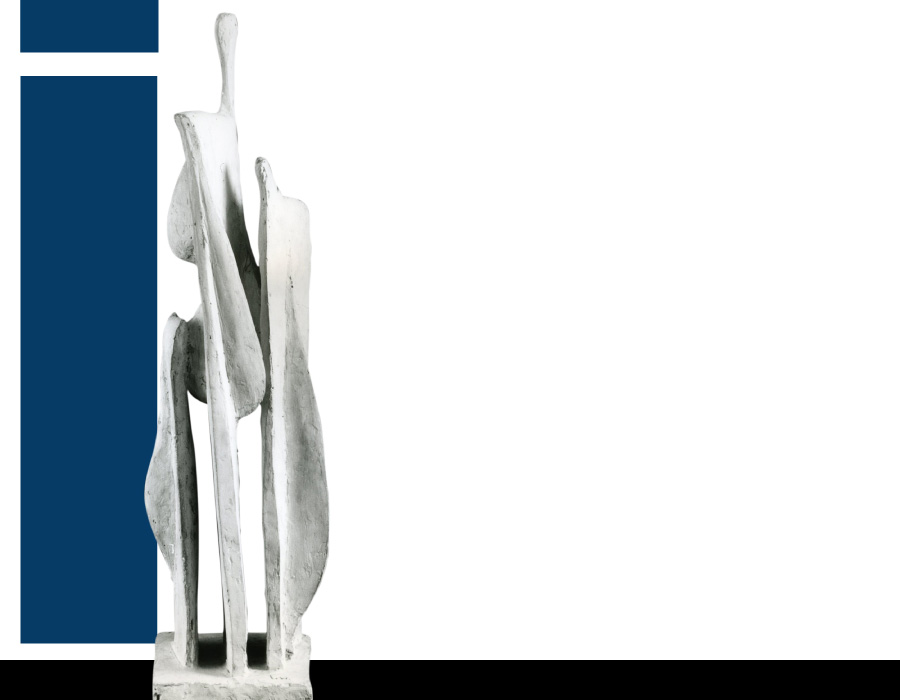
February. Michel Tapié organises the Sculpture d'un Temps Autre exhibition at Angers. Isabelle Waldberg chooses to display L'Entameur ('The Starter').
June. Takes part in the Exposition internationale de la Sculpture Contemporaine.
1957 March. Death of Brancusi. Isabelle Waldberg takes part in a sculptors' tribute organised at the Galerie Verneuil by Suzanne de Coninck.
June. IXe Salon de la Jeune Sculpture : Auto-Laocoon ('Auto-Laocoön, known later under the name of Laocoon – ' Laocoön'). Suivi de… ('Followed by …') illustrated in the catalogue.
November. The Musée des Beaux-Arts de Tours hosts Michel Tapié's exhibition until January 1958. The catalog contains a text by Tapié, "Actualité de la sculpture" ('The Current State of Sculture'), where it can be read: 'The way of abstraction […] opens up an infinite number of other routes without in fact rejecting any of those which we know already' . Etienne-Martin, François Stahly – two sculptors who Isabelle Waldberg knows well – actively take part in the this event which is carried along by lectures and animated debates.
Isabelle Waldberg displays Chair d'arbre ('Flesh of tree') at the event.
1958 Isabelle Waldberg takes a studio, 44 rue d'Orsel ; from now on, large sculptures such as the 'Hagarian' dynasty are born there, which are essential in her body of work; but also Monument pour une faillite ('Monument For A Bankruptcy') that appears as the artist's self-portrait signalling the beginning of a period of intense creation.
June. The Sculpture française contemporaine et de l'Ecole de Paris exhibition, held at the Musée Rodin, would be decisive as five sculptures in this vein would be displayed there.
Portrait de Marcel Duchamp('Portrait of Marcel Duchamp') (figurative).
1959 April. In the Salon Comparaisons, the Portrait d'A.L. ('Portrait of A.L.', Adrien Liegme, her sculptor friend) is similar to the work which Isabelle Waldberg is carrying out at the same time in Portrait secret ('Secret Portrait') and the Portrait de Marcel Duchamp ('Portrait of Marcel Duchamp'). These serve as 'non objective' evocations of the innermost and most hidden nature of human beings. It is at this moment that she completes Les Tesques ('The Tesques') before beginning Les Clues ('The Clues') which she describes thus: 'Abrupt rifts in a mountain … A book of stone, where what is written is fault-lines and emptiness.'
Receives the William Copley Prize, thanks to Marcel Duchamp and Jean Arp's votes.
Takes part in several group exhibitions: Galerie Claude Bernard (June-October) with Suivi de… ('Followed By …') ; Salon des Réalités Nouvelles with Agarien Ier ('Hagarian I').
1960 May. Solo exhibition, Galerie du Dragon. On this occasion Max Clarac-Sérou – who has been following the evolution of the artist for ten years - publishes a monograph on René de Solier.
Return to the Salon de Mai, after a ten-year hiatus ; it will thereafter exhbit regularly. Le Hallier ('The Thicket') displayed, while Les Clues ('The Clues') will be noticed in the Salon de la Jeune Sculpture. Receives the Prix Susse.
1961 March. Beginning of the Exposition internationale du Mouvement in Amsterdam, then in Stockholm organised by K.G. Hultén. A beech construction from 1943, called Wolk ('The Cloud') features in this event; it is reproduced in the catalogue.
At the Salon de Mai, Isabelle Waldberg exhibits La Rade ('The Harbour'): 'moving rectangle, square of security, area of perdition'.
At that time Robert Lebel notices 'a concentration, a further emphasised interiorisation of her sculpture'.
End of November. Winner of the Prix Bourdelle, supported by Jean Arp and Alberto Giacometti. The jury also rewards Jean Cardot, who, at that moment, is a figurative artist; a controversy springs up surrounding this choice which favours two trends - figurative and abstract - that are deemed contradictory. Michel Dufet will clearly restate the sovereign will of large-scale sculptors whose votes predominate within the jury. Denys Chevalier, in Aujourd'hui : Art et Architecture, applauds this result and pays a glowing tribute to Isabelle Waldberg's work.
1962 From May to September. Prix Bourdelle exhibition: Isabelle Waldberg displays twenty-two sculptures of which nine are bronzes. Le Musée d'Art Moderne de la Ville de Paris acquires Babylone ('Babylon') (1960). Michel Dufet designs the catalog.
The artist takes part in many events: Salon de la Jeune Sculpture, Exposition internationale du Petit Bronze ; Sculpture Contemporaine, exhibition organised by René de Solier at Le Havre.
July-August. Publication in L'Œil of an interview with Luce Hoctin, "Conversation dans l'atelier" ('Conversation in the studio').
The artist sculpts Le Double ('The Double'), Sculpture pour Michel ('Sculpture For Michel'), and L'Ecritoire ('the Writing Case').
December. Un demi-siècle de sculpture, Galerie du Cercle : exhibition on Robert Lebel's inititaive, who then publishes his Anthologie des formes inventées ('Anthology of Invented Forms').
1963 The sculptures appear to protect themselves from the outside world semblent by contraints: La Cuirasse ('the Breastplate'), La Châsse ('The Hunt'), Le Coffret ('The Box'), Le Mur ('The Wall'). Later we see a softening, an opening of forms which burst onto the day such as Habitation ouverte ('Open Living'), Palais rose ('Pink Palace'), and finally Le Grand Temps ('The Great Time').
Two exhibitions, Galleria Cadario in Milan. The first reunites twenty-two sculptures from 1956 to 1963. The list includes: Your Highness, Le Creuset ('The Crucible'), Diaphragme ('Diaphragm'), Pythagore ('Pythagoras'), Contrepoint ('Counterpoint'); Arbre ('Tree'), Les Ouvertures ('The Openings'), Berceau 'Cradle'), Le Protecteur ('The Protector'), Portrait intérieur II ('Inner Portrait II'); Prélude ('Prelude') and Cadence ('Cadence') (two painted plaster sculptures which date from 1963) …
The second event displays small bronzes and tinted plaster sculptures.
1964 In the Salon de la Jeune Sculpture, Isabelle Waldberg displays La Bâtisse ('The Building') and a drawing; also takes part in Salon de Mai.
Takes part in a group exhibition organised by Jacqueline Ranson at the Cinéma Le Ranelagh (text by Hubert Juin in the catalogue which is devoted to her).
1965 February. Miguel Berrocal and Etienne-Martin invite Isabelle Waldberg to take part in their exhibition which takes place at Galleria Ferrari in Verona. This friendly proposal allows the artist to display her more recent works, with Berrocal, Etienne-Martin and Penalba.
Exhibits at the Musée d'Art Moderne de la Ville de Paris: Un groupe 1965, introduced by André Chastel.
Displays Le Grand Temps 'The Great Time') at the Salon de Mai and takes part in the La Main exhibition given by the Galerie Claude Bernard (from 14 December 1965 to 15 February 1966).
1966 Claude Givaudan organises an exhibition of contemporary sculptors, with the artist figuring among them. He prepares a book-catalog on this occasion.
Displays Rencontre à mi-hauteur ('Meeting At Mid-height') at the Salon de Mai while Your Highness features in the Salon de la Jeune Sculpture.
1967 Year of intense artistic activity: Isabelle Waldberg completes La Druse ('The Druse'), Glyptothèque ('Glyptotheque'), Tête ('Head'), Portrait de Robert Lebel ('Portrait of Robert Lebel').
March. Private exhibition is devoted to her at the Maison de la Culture d'Amiens, that displays her works from the last ten years including Portrait d'A.L. (Portrait of A.L.') and Le Toit ('The Roof').
Takes part in L'Age du Jazz, Musée Galliéra; at the Salon de Mai in Paris, then takes part in the selection sent to Cuba, Havana and Santiago de Cuba (from July to November); finally displays Le Murcien ('The Murcian') in the Salon de la Jeune Sculpture.
Publication details in Monographs and general works.
– biography 1956 to 1967 –
